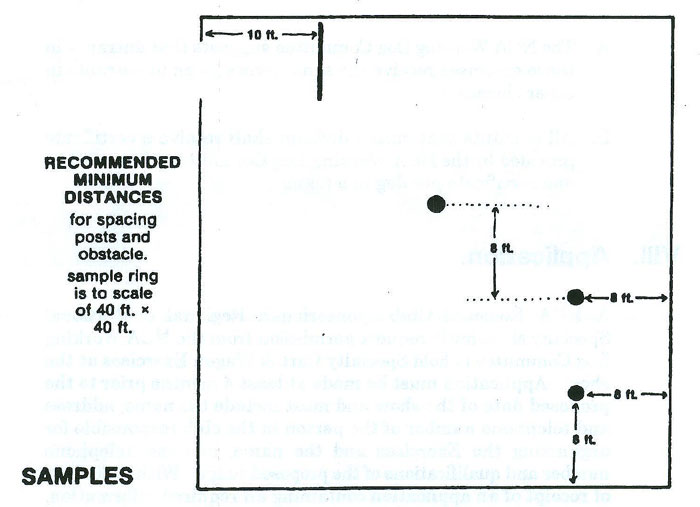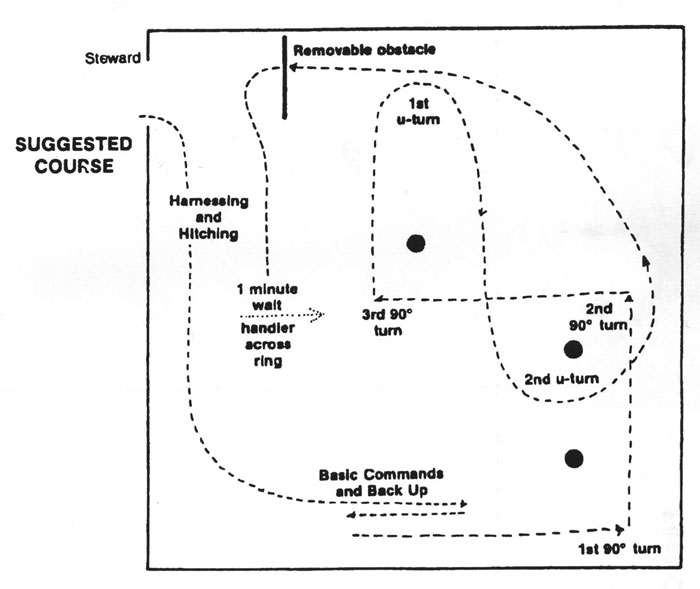Approved 1984
The Specialty Cart and Wagon Exercises have been developed to meet a demand for standardized exercises to be used at Specialty shows. Because Specialty shows generally have facilities only for carts and wagons, other draft apparatus have largely been ignored for these exercises. The exercises have also been designed largely for people interested in exhibition cart and wagon activities. Therefore the exercises have been chosen to test the abilities of dog and handler to meet the tasks required for activities such as parade carting. Even so, these regulations also attempt to stress a working relationship between dog and handler. Judging is on a pass/fail basis because every-day cart and wagon activities are diverse; no standard short set of exercises can adequately test all draft abilities of all dogs entered.
Regulations and Descriptions
1. Divisions and Exercises
2. Automatic Failure
3. Judge
4. Judging Guidelines
5. Stewards
6. Equipment
7. Certificates and Favors
8. Application
1. Divisions and Exercises.
A. There will be 2 divisions, On-Lead and Off-Lead, into which there can be individual and team entries.
Individual dogs and teams may be entered in either division or both divisions; those that fail in On-Lead may not compete in Off -Lead. On-Lead Division will be judged first and in each division individual entries will be judged before teams. A dog or team that passes On-Lead Division may immediately attempt Off Lead Division without repeating the Harnessing and Hitching exercise.A team consists of 2 or more dogs working together with only 1 handler; failure of any single dog in a team on any point constitutes failure for the entire team.
B. On-Lead Exercises and Descriptions.
A sample course for the exercise is provided below.
Harnessing and Hitching.
a. The dog allows itself to be harnessed and cooperates in being harnessed.
b. The dog allows itself to be hitched to a cart or wagon and cooperates with the hitching.
c. A dog or team that passes On-Lead Division and immediately attempts Off-Lead Division is considered to have passed Harnessing and Hitching for Off -Lead Division.
Basic Commands.
a. The dog must be able to perform the following tasks:
i. Pull the cart / wagon forward at a normal hauling pace.
ii. Respond correctly to a command to pull more slowly.
iii. Respond correctly to a command to halt.
iv. Back up 3 measured feet.
b. During the exercise the handler may walk next to, before or behind the dog; the handler may face the dog to command him to back.
Maneuvering Course.
a. While staying close to and attentive to the handler, the dog must maneuver a course with
i. 3 broad 90° turns.
ii. 2 broad U-turns.
iii. A removable obstacle.
b. The handler may request that markers for turns be moved slightly if the allowed turning space is inadequate for the cart/ wagon being used; space for turns should not be so tight as to require a stationary wheel on a cart/wagon during a turn.
c. During the exercise the handler may walk next to, before or behind the dog:
d. The dog may not knock over the markers for turns.
e. The removable obstacle should be something the dog could walk under, over or through were it not hitched to the cart/wagon.
f. The dog may not pass the removable obstacle until the handler has moved the obstacle so that the dog and cart / wagon can pass safely and has commanded the dog to do so
C. Off -Lead Exercises and Descriptions.
Harnessing and hitching are the same as in I.B.2. except that the dog is off -lead.
Basic Commands are the same as in I.B.3. except that the dog is off -lead.
Maneuvering Course is the same as in I.B.4. except that the dog is off -lead
One Minute Stay.
a. The handler commands the dog to be in the position he wishes for this exercise (stand, sit or down are all acceptable); the dog must be able to be in that position comfortably while hitched.
b. The handler commands the dog to stay.
c. The handier walks across the ring and waits for 1 minute.
d. Upon a signal from the judge, the handler returns to his dog.
e. The dog must remain in position and in place where commanded to stay.
Automatic Failure
Dogs and handlers doing any of the following automatically fail.
The dog leaves the ring; the judge may use his discretion as to whether the dog will be allowed to complete the exercises.
The dog upsets the cart/wagon; the judge may use his discretion as to whether the dog will be allowed to complete the exercises.
The dog eliminates in the ring; the judge may use his discretion as to whether the dog will be allowed to complete the exercises.
The dog is not under control; the dog may not complete the exercises but will be dismissed immediately.
If the handler has placed a load in the cart / wagon, the load is too heavy for the dog's condition; the judge may use his discretion as to whether the dog will be allowed to complete the exercises.
The dog or handler’s behavior threatens the safety of the dog, the handler, some other dog or person, or physical property; the dog may not complete the exercises but will be dismissed immediately.
Judge
A. There will be one (1) judge whose decision is final.
B. The judge will be chosen on experience in working with Newfoundland dogs in draft work or some other work capacity.
Judging Guidelines
A. All exercises will be judged pass/fail using a standardized score sheet supplied by the NCA Working Dog Committee.
B. Before any judging begins, the judge should explain the exercises and his criteria for judging to the handlers. Thereafter, while judging, the judge need only ask each handler if he has any questions.
C. A dog and handler must pass all exercises and not commit an Automatic Failure to obtain a certificate for passing the division in which they were entered.
D. The judge will consider the following criteria in judging an exercise:
Has the dog shown the basic ability being tested?
Has the dog worked willingly without fear of its handler?
Has the dog performed the exercise without wasting considerable time?
E. The handler should not touch the dog during exercises except as necessary for harnessing and hitching.
F. Dogs in On-Lead Division should not be subjected continuously to a tight lead.
G. Talking, praising, multiple commands and multiple signals are permitted for all exercises except the Off -Lead Division One Minute Stay.
H. A dog that is incorrectly harnessed or hitched and therefore fails that exercise must be correctly harnessed and hitched before proceeding with the other exercises.
I. Suggested judge's commands for the exercises are:
Harnessing and Hitching: "Harness your dog", "Hitch your dog", "Exercise finished".
Basic Commands: "Command your dog to pull", "Slow", "Halt", "Back your dog", "Exercise finished".
Maneuvering Course: The judge should make certain that the handler understands the course he is to traverse with his dog; "Take the course", "Halt" (after the handler and dog have safely passed the movable obstacle), "Exercise finished".
One-Minute Stay: "Command your dog into your chosen position", "Leave your dog", "Return to your dog", "Exercise finished".
Stewards
A. There will be at least 1 steward.
B. The steward(s) will assist the judge as needed and directed by the judge.
C. The steward(s) will assist the handler with equipment prior to the Harnessing and Hitching exercises as needed.
D. The steward(s) will block the ring exit during the One Minute Stay.
Equipment:
The Regional Club sponsoring the specialty will provide:
A. Judging score sheets. These should be requested from the Land Work Secretary of the WDC prior to the date of the Specialty.
B. At least 3 markers to delineate the course; these could be traffic pylons, small posts, or similar objects; though standard obedience equipment could be used it is discouraged as such equipment is not found in most cart/wagon situations.
C. A removable obstacle; this could be a log or branches, traffic pylons, part of a fence or gate, or similar objects; though standard obedience equipment could be used it is discouraged as such equipment is not found in most cart/wagon situations.
D. A 3-foot measure to be placed on the ground next to each dog to measure the backing distance.
E. A ring at least 2500 square feet in size; recommended locations for markers and obstacles are shown below.
F. Suggested: Some system, such as a placard or grid, by which the audience can be silently informed as each entrant passes or fails.
G. The Regional Club may use its ingenuity in adapting the exercises and the course to demonstrate their functional origins.
Certificates and Favors
A. The NCA Working Dog Committee suggests that entrants in these exercises receive the same favors given to entrants in other classes.
B. All entrants that pass a division shall receive a certificate provided by the NCA Working Dog Committee; there will be one certificate per dog in a team.
Application
An NCA Regional Club sponsoring a Regional or National Specialty show must request permission from the NCA Working Dog Committee to hold Specialty Cart & Wagon Exercises at the show. Application must be made at least 4 months prior to the proposed date of the show and must include the name, address and telephone number of the person in the club responsible for organizing the Exercises and the name, address, telephone number and qualifications of the proposed judge. Within 30 days of receipt of an application containing all required information, the NCA Working Dog Committee Land Work Secretary will notify the specified club member whether permission has been granted and will send master copies of all standardized materials needed to hold the event.

